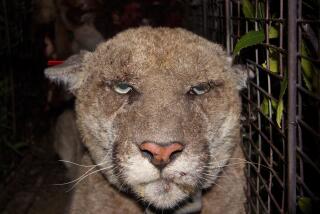Coyote Conflict : Adaptable Predator and Man Continue to Clash
The coyote is a wilderness symbol of the American West, but usually an unwelcome guest in the urban foothill neighborhoods of San Fernando and neighboring valleys.
These wolf-like canines have roamed Southern California hills since the Pleistocene era and now have made their way into city streets and yards near the Santa Monica Mountains, controlling rodents but also scavenging garbage cans and at times attacking small pets.
Increased sightings of coyotes, especially in the West Valley, are attributed to a number of factors, including the ban of coyote trapping, in effect since June. The recent fires may also be forcing coyotes to forage for food in urban areas.
The conflict over the trapping ban has been heated between residents concerned with protecting pets and children and animal rights groups. The clash has intensified since Dec. 17, when an animal regulation officer shot and killed a coyote that appeared to be stalking a small dog in Woodland Hills.
The city’s Animal Regulation Commission will meet Monday to reconsider the ban on coyote trapping. The 10 a.m. meeting will be held at 419 S. Spring St. in downtown Los Angeles.
The Trapping Controversy
Until the ban in June, the city had trapped coyotes for about 25 years. Humane box-type traps had been used since October, 1992, when a moratorium was placed on the use of leg-hold traps.
A look at the traps:
Leg trap: The steel-jawed leg-hold trap was banned in 1970 and replaced with the offset padded leg-hold trap. Leg-hold traps were considered cruel to coyotes and jeopardized the safety of other animals. Coyotes trapped this way often chewed off their legs to free themselves. Private trappers are still allowed to used padded leg traps.
Box trap: Also used to trap injured or wild dogs, this wire cage is left open with food bait placed toward the back. As the animal approaches the food, it steps on a steel plate, slamming the door behind it. Animal regulation officers remove the coyote and later shoot or euthanize it.
Coyote Profile
(Canis latrans)
Body size: 4 to 4 1/2 feet long, including the tail/
Weight: 30 to 50 pounds.
Color: Varies from light tan or gray to brown. Bushy tail is tipped in black or brown and is held between legs when running.
Voice: Distinctive howl, mixed with yaps, usually at dusk or before dawn.
Longevity: In captivity, for more than 14 years.
Habitat: Prefers oak woodlands, grasslands and chaparral, but often roams hillside neighborhoods and yards in search of food.
Habits: Mostly nocturnal. They are opportunistic feeders, eating whatever is available, including rodents, fruit, insects, pet food and garbage. Can run up to 35 m.p.h. and cover 10 to 15 miles a night. Normally dens in ground, but often uses other shelter no more than six miles from water. Some live full time in urban areas such as vacant lots. Has been known to mate with domestic dogs. Young are born in April and May.
Keeping Coyotes Away
Tips from the Department of Animal Regulation:
Never feed coyotes.
Cover trash bins.
Never leave pets or their food outdoors.
Remove ripened fruit from trees and ground.
Fence yards on bushy slopes; Coyotes can dig under fences and scale fences more than 6 feet high. Bury the bottom of a fence at least 6 to 12 inches. A fence at least 8 feet high and tilted 45 degrees outward, away from yard, has deterred coyotes.
Who to Call
There is currently no government agency that will trap coyotes in the city of Los Angeles.
*
The agencies involved and their recommendations:
Department of Animal Regulation: Provides a brochure on coexisting with coyotes, with tips and animal shelter phone numbers. Call (213) 893-8400 for more information or the department’s West Valley shelter at (818) 882-8800 or East Valley shelter at (818) 764-7061.
Department of Fish and Game: Provides education to the public but will not act on any request for coyote removal.
Los Angeles County Agricultural Commission: Will not trap coyotes in the city, but will do so for a fee on a very limited basis in unincorporated areas.
*
Sources: Los Angeles Department of Animal Regulation; Reader’s Digest North American Wildlife; Research by Julie Sheer / Los Angeles Times
More to Read
Sign up for Essential California
The most important California stories and recommendations in your inbox every morning.
You may occasionally receive promotional content from the Los Angeles Times.










